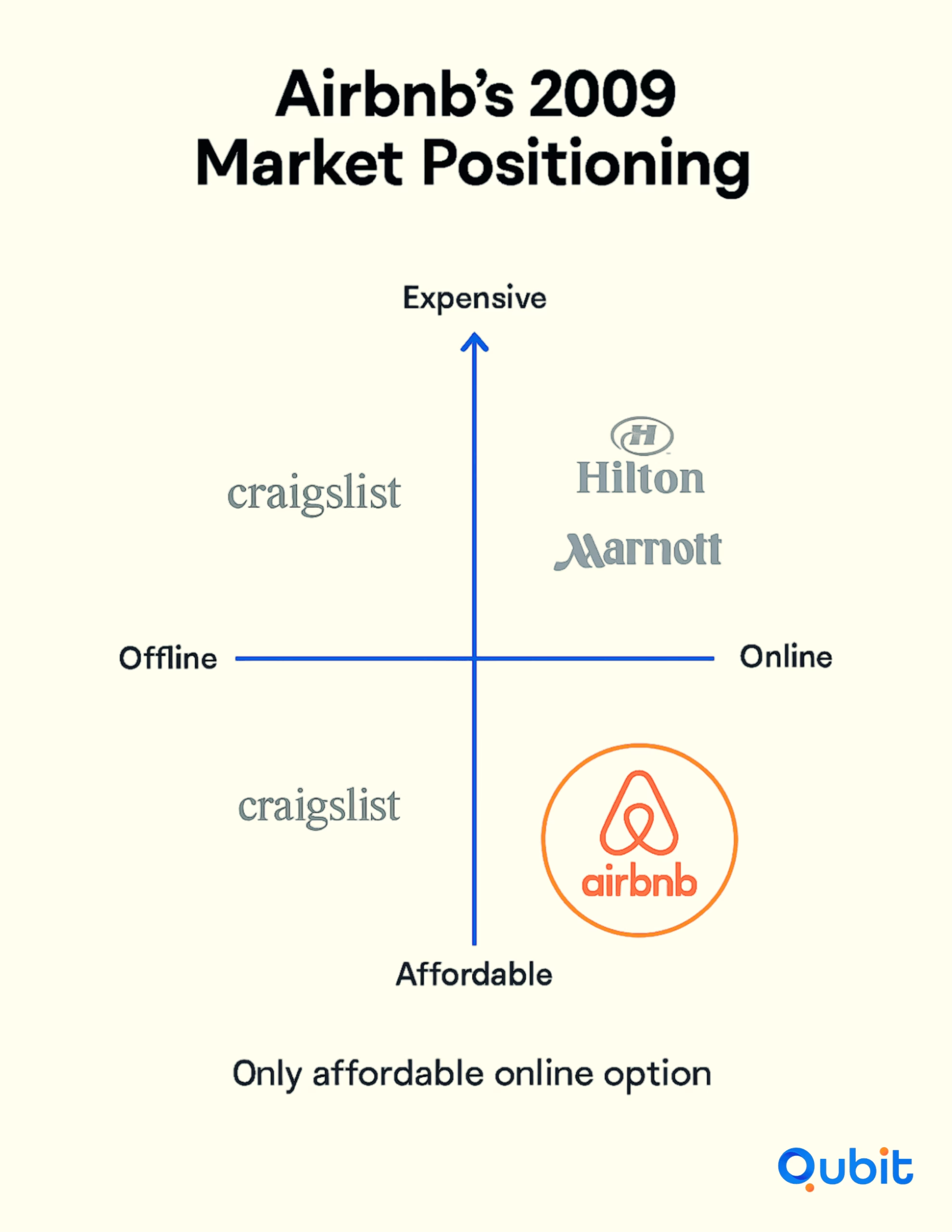A standout pitch deck is your ticket to capturing investor interest and unlocking startup funding. At the heart of it lies the competition slide, a powerful way to showcase your market insight and strategic edge. Investors expect a clear picture of how you stack up against rivals and what differentiators make you the smart bet. Nail this slide by combining concise visuals with razor-sharp analysis of your industry landscape.
To create a strong pitch deck foundation for your pitch deck, it’s crucial to understand the overall structure and investor-focused strategies. In this guide, we’ll explore actionable steps to design a competition slide that resonates with investors and strengthens your pitch.
How to Build an Effective Competition Slide
Building a powerful competition slide begins with choosing the right framework, juxtaposing familiar tools like the Magic Quadrant against the more nuanced Power Grid model. Follow these steps to map your competitive landscape in a way that meets investor standards and spotlights your startup’s distinctive strengths.
1. Choose the Right Framework
The framework you select sets the tone for how your competition slide will be perceived. While the Magic Quadrant has been a popular choice, it often lacks the depth needed to differentiate your startup effectively. The Power Grid approach offers a more nuanced perspective, allowing you to showcase your competitive edge through quantifiable metrics.
- Magic Quadrant: In this method you place competitors into four quadrants based on their market position and execution capabilities. While simple, it may oversimplify your narrative and fail to highlight unique differentiators.
- Power Grid: Unlike the Magic Quadrant, the Power Grid emphasizes specific metrics such as product features, pricing, and customer satisfaction. This approach enables you to present a more detailed and credible analysis of your competitive landscape.
2. Structure Your Slide for Maximum Impact
A well-structured competition slide is essential for capturing investor attention. Begin by clearly defining the axes or metrics that will frame your analysis. These should align with the priorities of venture capital for startups, such as scalability, innovation, and market demand.
- Axes Selection: Choose metrics that highlight your strengths while addressing investor concerns. For example, focus on customer retention rates or technological superiority.
- Visual Clarity: Use clean, professional visuals to ensure your slide is easy to interpret. Avoid clutter and ensure that each data point is clearly labeled.
3. Quantify Your Competitive Edge
Investors value data-driven insights. Quantifying your competitive advantages not only builds credibility but also demonstrates your understanding of the market.
- Metrics to Include: Highlight measurable factors such as market share, growth rate, or customer acquisition costs.
- Data Presentation: Use charts, graphs, or tables to present your data in a visually appealing manner. This makes it easier for investors to grasp your position in the market.
4. Finalize with a Clear Narrative
Your competition slide should tell a story that aligns with your overall pitch deck. Tie your competitive analysis back to your value proposition and explain how your startup addresses gaps in the market.
- Storytelling: Use your slide to illustrate why your solution is uniquely positioned to succeed.
- Investor Alignment: Ensure your narrative resonates with the priorities of investors who invest in startups, such as scalability and long-term growth potential.
Airbnb Competition Slide Example

- Axes: the horizontal axis runs Offline ⇄ Online, while the vertical axis shows Expensive ⇄ Affordable.
- Placement: Airbnb’s logo sits alone in the top-right quadrant—the only option that is both online and affordable. Traditional hotel brands (e.g., Marriott, Hilton) appear in the online-but-expensive quadrant; low-cost classified sites like Craigslist occupy the offline-and-affordable quadrant; Couchsurfing is mapped as online-and-free but “too informal” on price perception.
- Visual cues: each competitor is represented by a small greyscale logo. Airbnb’s mark is in full colour and slightly larger, instantly drawing the eye to its differentiated position.
Why it works
- Minimal text, maximal contrast: the slide contains no bullet points—just the matrix, four-to-six logos, and a one-line caption (“Only affordable online option”). The white space keeps focus on positioning rather than feature lists.
- Instant clarity: investors digest the competitive landscape in one glance because the axes speak to value drivers they already track—price and booking channel.
- Implicit traction story: by combining online with affordability, Airbnb signals scalability and mainstream appeal without extra words.
Understanding your audience is crucial when crafting a competition slide. For more guidance on aligning your pitch deck with investor expectations, explore how to tailor pitch deck for investors.
Prove Your Market Position to Win Investor Trust
Establishing a strong market position is critical for startups seeking funding. Investors want to see evidence that your business can thrive in a competitive environment. Comprehensive market validation, backed by detailed research and competitor analysis, is the cornerstone of building this trust.
Showcase Market Validation with Data
When pitching to investors, presenting a clear understanding of your market size and scope is essential. A well-crafted TAM Slide can be a powerful tool to demonstrate the potential of your market. Use this TAM Slide reference to strengthen the market sizing portion of your deck. It provides guidance on how to effectively quantify your Total Addressable Market (TAM), ensuring your projections are both realistic and compelling.
Analyze Competitors Realistically
Acknowledging your competitors is not a sign of weakness—it’s a sign of preparedness. Investors appreciate when startups provide a realistic competitor analysis, as it shows you understand the challenges and opportunities within your industry. Highlighting your unique value proposition in comparison to competitors can further solidify your market position.
Strategic Slide Placement Matters
The placement of your market validation slides within your pitch deck can significantly impact how investors perceive your business. A nuanced examination of visual layout and clarity reinforces the discussion on pitch deck design principles, offering insights that enhance the overall appearance of your presentation. By strategically positioning your TAM Slide and competitor analysis, you can maintain a consistent flow that keeps investors engaged.
Build Investor Confidence
Investors are more likely to fund a startup business when they see evidence of thorough market research and a clear strategy for addressing competition. By combining robust data with strategic presentation, you can demonstrate that your startup is poised for success in a competitive market.
Your Guide to Competitive Analysis and Strategy
Investors back founders who can pinpoint their competitive position—and prove they can out-maneuver rivals. Drawing on 25 expert sources, we distil the six factors investors cite most when judging a competition slide. Use each element in proportion to its real-world weight to keep your deck sharp and credible for startups looking for investors.
Assess Your Market Landscape with Full Transparency
Investors back founders who admit the tough truths. Map every direct and indirect rival, note their market shares, and flag looming substitutes. Clear-eyed context shows that startups looking for investors know exactly what they’re up against.
Dive Deep Into Research to Gain Clarity
Depth beats breadth. Mix analyst reports, customer interviews, and review-site scraping, then compress findings into one clean comparison grid. For extra pointers, watch the DreamIt video on competitive analysis.
How to Define Realistic Market Goals
Ambition is good; believable numbers are better. Anchor goals like “5 % SOM in three years” to bottom-up data so early stage startups look disciplined, not over-eager.
Put Your Customer’s Needs at the Center
Frame each competitor by how well they solve buyer pain—speed, cost, reliability. Then state how you solve it better or for a niche they miss.
Focus Your Analysis on Tangible Benefits
Translate features into outcomes: “onboarding 50 % faster,” “churn 20 % lower.” Hard numbers help investors picture the upside.
Shine a Light on Your Strategic Strengths
Close with the quiet moats—exclusive partnerships, proprietary data, patents—that don’t fit standard tables but raise your defensibility.
Conclusion
Crafting a competition slide that resonates with investors requires a thoughtful approach. Throughout this blog, we explored essential strategies and frameworks, including the Power Grid, detailed competitor analysis, and realistic market validation. These tools not only help clarify your startup's position but also build credibility and trust with potential investors.
A well-designed competition slide is more than just a visual—it’s a strategic asset that communicates your understanding of the market and your ability to succeed within it. By applying the actionable steps discussed, you can ensure your pitch deck stands out and effectively conveys your value proposition.
Ready to refine your pitch deck and secure funding?. Discover our Pitch Deck Creation service to transform your pitch into a success story.
Key Takeaways
- A compelling competition slide highlights your unique position, builds investor trust, and validates key market assumptions.
- The Power Grid delivers multidimensional insights—combining factors like pricing, features, and market reach—for clearer differentiation than traditional Magic Quadrants.
- Incorporating quantifiable metrics and thorough competitor research boosts the impact and credibility of your analysis.
- Validating your market through TAM, SAM, and SOM figures underscores your assumptions and demonstrates growth potential.
- A clear, data-driven competitive analysis not only informs strategic decisions but also enhances communication with investors.
Frequently asked Questions
What is the competition slide on the startup deck?
The competition slide is a crucial part of a startup pitch deck. It highlights your competitors—both direct and indirect—to demonstrate market activity and validate your business’s relevance. This slide also serves to showcase your strategic positioning and how your solution stands out in the competitive landscape.


 Back
Back



